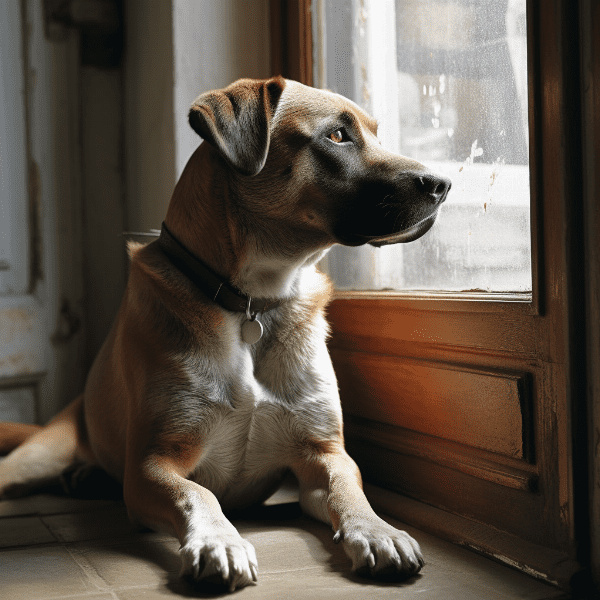Table of Contents
- The Nature of Canine Behavior: An Overview
- Understanding the Different Types of Barking
- Common Triggers of Excessive Barking in Dogs
- Separation Anxiety and Its Role in Barking Behavior
- The Importance of Early Socialization and Training
- Tips for Managing Your Dog’s Barking Behavior
- Techniques for Reducing Barking through Positive Reinforcement
- Using Technology to Address Barking Behavior
- When to Seek Professional Help for Your Dog’s Barking
- Conclusion: A Happy and Quiet Life with Your Canine Companion
The Nature of Canine Behavior: An Overview
Understanding your dog’s behavior is key to addressing their barking habits. Dogs have a unique way of communicating through their barks, growls, and body language. It’s essential to recognize that barking is a natural form of communication for dogs and that it can have various meanings.
The Role of Instinct in Barking Behavior
Barking is a natural instinct for dogs. In the wild, dogs bark to alert their pack members of potential dangers, signal their location, and communicate with other animals. When domesticated, dogs still rely on their instincts to communicate with humans and other animals. Understanding the natural instincts of your dog can help you better understand and manage their barking behavior.
The Influence of Breed and Temperament on Barking
Breed and temperament can play a significant role in a dog’s barking behavior. Some breeds are more prone to excessive barking than others. For example, guard dogs and hunting dogs are bred to bark as a part of their job. Additionally, a dog’s temperament can also affect their barking behavior. Nervous or anxious dogs may bark more frequently than confident and relaxed dogs.
The Impact of Environment on Barking
The environment your dog is in can also play a role in their barking behavior. A dog that is left alone for extended periods may bark out of boredom or loneliness. On the other hand, a dog that is surrounded by constant noise and commotion may also bark more frequently. Understanding how your dog’s environment impacts their barking behavior can help you manage and reduce excessive barking.
The Importance of Proper Socialization and Training
Proper socialization and training are essential in preventing excessive barking behavior in dogs. Early socialization can help your dog learn appropriate ways to interact with humans and other animals. Positive reinforcement training can also help teach your dog when it’s appropriate to bark and when it’s not.

Understanding the Different Types of Barking
Not all barking is the same, and different types of barking can indicate different things. Understanding the different types of barking can help you better communicate with your dog and manage their behavior.
Alert Barking
Alert barking is when your dog barks in response to a perceived threat or danger. It’s a natural instinct for dogs to alert their owners of potential dangers, such as an unfamiliar person or animal in their territory. Alert barking is usually brief and stops once the perceived threat has passed.
Territorial Barking
Territorial barking is when your dog barks to protect their territory. It’s common for dogs to bark when they see or hear someone approaching their home or yard. Territorial barking can become excessive if your dog continues to bark long after the person or animal has left their territory.
Playful Barking
Playful barking is when your dog barks during playtime or when they’re excited. It’s usually accompanied by tail wagging and other playful behaviors. Playful barking is usually short-lived and stops once playtime is over.
Separation Anxiety Barking
Separation anxiety barking is when your dog barks excessively when left alone. Dogs with separation anxiety may bark, whine, or howl when their owners leave the house. Separation anxiety barking can be difficult to manage and may require professional help.
Attention-Seeking Barking
Attention-seeking barking is when your dog barks to get your attention. It’s common for dogs to bark when they want to play, go outside, or get a treat. Attention-seeking barking can become excessive if your dog continues to bark even after they’ve received attention.
Fearful Barking
Fearful barking is when your dog barks in response to something that scares them. Dogs may bark when they hear loud noises, such as thunder or fireworks, or when they encounter new or unfamiliar people or animals. Fearful barking can be difficult to manage and may require desensitization training.
Understanding the different types of barking can help you identify the cause of your dog’s excessive barking and take the necessary steps to manage their behavior. In the following sections, we’ll explore common triggers of excessive barking and provide tips for managing your dog’s barking behavior.

Common Triggers of Excessive Barking in Dogs
Excessive barking can be caused by a variety of triggers, and identifying the cause is key to managing your dog’s behavior. In this section, we’ll explore some common triggers of excessive barking in dogs.
Lack of Exercise and Stimulation
Dogs that don’t get enough exercise or mental stimulation may bark out of boredom or frustration. It’s essential to provide your dog with enough exercise and activities to keep them mentally and physically stimulated.
Environmental Factors
Environmental factors such as loud noises, other animals, or strangers can trigger excessive barking in dogs. Dogs may bark when they hear thunder, sirens, or fireworks, or when they see other animals or people they perceive as a threat.
Fear and Anxiety
Fear and anxiety can also trigger excessive barking in dogs. Dogs may bark when they’re scared or anxious about something, such as going to the vet or being left alone.
.

Separation Anxiety and Its Role in Barking Behavior
Separation anxiety is a common behavioral issue in dogs that can lead to excessive barking when left alone. In this section, we’ll explore the role of separation anxiety in barking behavior and provide tips for managing this issue.
Understanding Separation Anxiety
Separation anxiety is a condition in which dogs experience intense anxiety and distress when separated from their owners. Dogs with separation anxiety may bark, whine, howl, destroy furniture or other items, and engage in other destructive behaviors. This condition can be challenging to manage and may require professional help.
The Role of Separation Anxiety in Barking Behavior
Separation anxiety can be a significant factor in excessive barking behavior in dogs. Dogs with separation anxiety may bark excessively when left alone as a result of their anxiety and distress. This behavior is often accompanied by other symptoms such as destructive behavior and house soiling.
Tips for Managing Separation Anxiety-Related Barking
Managing separation anxiety-related barking can be challenging, but there are several things you can do to help your dog feel more comfortable when left alone. These include:
- Gradual desensitization: Gradually acclimate your dog to being left alone by starting with short periods and gradually increasing the time.
- Positive reinforcement training: Reward your dog for calm behavior when left alone, such as lying down or playing with toys.
- Provide plenty of exercise and mental stimulation: Dogs that are tired and mentally stimulated are less likely to engage in destructive behavior.
- Use calming aids: Products such as calming pheromones or music can help soothe anxious dogs.
When to Seek Professional Help
By understanding the role of separation anxiety in barking behavior and taking the necessary steps to manage this condition, you can help your dog feel more comfortable and reduce excessive barking.

The Importance of Early Socialization and Training
Proper socialization and training are crucial for preventing excessive barking behavior in dogs. In this section, we’ll explore the importance of early socialization and training and provide tips for getting started.
Early Socialization
Early socialization involves exposing your puppy to a variety of people, animals, and environments to help them become comfortable and confident in different situations. Socialization should begin as early as possible, ideally when your puppy is between 3 and 14 weeks old.
The Benefits of Early Socialization
Early socialization can help prevent excessive barking behavior by teaching your puppy appropriate ways to interact with people and animals. It can also help your puppy become more confident and less fearful in new situations, which can reduce anxiety and stress.
Positive Reinforcement Training
Positive reinforcement training is a training method that involves rewarding good behavior with treats, praise, or other positive reinforcements. This type of training can help teach your dog appropriate barking behavior and reduce excessive barking.
The Benefits of Positive Reinforcement Training
Positive reinforcement training can help reduce excessive barking behavior by teaching your dog when it’s appropriate to bark and when it’s not. It can also help build a strong bond between you and your dog and improve their overall behavior.
Tips for Early Socialization and Training
- Start early: Begin socialization and training as early as possible to help prevent excessive barking behavior.
- Be consistent: Consistency is key when it comes to training. Use the same commands and rewards every time to avoid confusion.
- Use positive reinforcement: Positive reinforcement training is the most effective way to teach your dog appropriate behavior.
- Expose your dog to different situations: Expose your dog to a variety of people, animals, and environments to help them become more comfortable and confident.
By providing your puppy with proper socialization and training, you can help prevent excessive barking behavior and ensure a happy, healthy relationship with your dog.

Tips for Managing Your Dog’s Barking Behavior
Managing your dog’s barking behavior can be challenging, but there are several things you can do to help reduce excessive barking. In this section, we’ll provide tips for managing your dog’s barking behavior.
Identify the Cause
Identifying the cause of your dog’s barking behavior is the first step in managing their behavior. As we’ve discussed, barking can be caused by a variety of factors, including anxiety, boredom, and environmental triggers. Once you’ve identified the cause, you can take steps to address the behavior.
Provide Plenty of Exercise and Stimulation
Dogs that are tired and mentally stimulated are less likely to engage in excessive barking behavior. Make sure your dog gets plenty of exercise and activities to keep them mentally and physically stimulated.
Use Positive Reinforcement Training
Positive reinforcement training is the most effective way to teach your dog appropriate barking behavior. Reward your dog for good behavior with treats, praise, or other positive reinforcements. Be consistent with your training to avoid confusion.
Use Calming Aids
Products such as calming pheromones, music, and supplements can help soothe anxious dogs and reduce excessive barking behavior. Talk to your veterinarian about which calming aids may be right for your dog.
Manage Environmental Triggers
Environmental triggers such as loud noises, other animals, and strangers can cause excessive barking behavior in dogs. Manage these triggers by keeping your dog in a quiet, comfortable space away from potential stressors.
Seek Professional Help
If your dog’s barking behavior is severe or difficult to manage, it’s essential to seek professional help. A veterinarian or animal behaviorist can provide guidance and support in managing your dog’s barking behavior.
By following these tips, you can help manage your dog’s barking behavior and ensure a happy, healthy relationship with your furry friend.

Techniques for Reducing Barking through Positive Reinforcement
Positive reinforcement training is a highly effective way to reduce excessive barking behavior in dogs. In this section, we’ll explore some techniques for reducing barking through positive reinforcement.
Teach the “Quiet” Command
Teaching your dog the “quiet” command is an effective way to reduce excessive barking behavior. To teach the command, wait for your dog to start barking, then say “quiet” and wait for them to stop barking. Once they stop barking, reward them with a treat or praise. Repeat this process until your dog associates the “quiet” command with stopping barking.
Reward Good Behavior
Rewarding good behavior with treats, praise, or other positive reinforcements is a highly effective way to reduce excessive barking behavior. When your dog exhibits calm behavior and refrains from barking, reward them with a treat or praise. This will reinforce good behavior and help reduce excessive barking.
Use Distraction Techniques
Distraction techniques such as toys, treats, or games can be highly effective in reducing excessive barking behavior. When your dog starts barking, distract them with a toy or treat to redirect their attention. This will help teach them that barking is not the only way to get attention or rewards.
Avoid Punishment
Punishing your dog for barking is not an effective way to reduce excessive barking behavior. Punishment can cause fear and anxiety in your dog, which can exacerbate the problem. Instead, focus on positive reinforcement training and reward good behavior.
Be Consistent
Consistency is key when it comes to reducing barking behavior through positive reinforcement. Use the same commands and rewards every time to avoid confusion. Consistency will help your dog learn what behavior is expected of them and reduce excessive barking.
By using these techniques, you can effectively reduce excessive barking behavior in your dog and build a stronger bond with them through positive reinforcement training.

Using Technology to Address Barking Behavior
Technology can be a helpful tool in addressing barking behavior in dogs. In this section, we’ll explore some of the ways technology can be used to manage excessive barking.
Anti-Bark Collars
Anti-bark collars are a type of collar that delivers a small shock or spray of citronella when your dog barks excessively. While these collars can be effective in reducing barking behavior, they should be used with caution and under the guidance of a professional.
Ultrasonic Devices
Ultrasonic devices emit a high-pitched sound when your dog barks excessively. These devices are designed to be aversive to dogs and discourage barking behavior. While some dogs may be sensitive to ultrasonic sounds, others may not be affected.
Smart Collars
Smart collars are a type of collar that uses GPS and other technology to track your dog’s location and activity levels. Some smart collars also have barking sensors that can detect when your dog barks excessively and send alerts to your phone. This can be helpful in monitoring your dog’s behavior and addressing excessive barking.
Treat-Dispensing Cameras
Treat-dispensing cameras are a type of camera that allows you to monitor your dog’s behavior and dispense treats remotely. Some treat-dispensing cameras also have barking sensors that can detect when your dog barks excessively and dispense treats as a reward for quiet behavior.
Noise-Canceling Headphones
Noise-canceling headphones can be helpful in reducing anxiety and stress in dogs that are sensitive to loud noises. These headphones can be particularly helpful in reducing excessive barking behavior caused by environmental triggers such as thunder or fireworks.
While technology can be a helpful tool in managing excessive barking behavior, it should be used in conjunction with positive reinforcement training and under the guidance of a professional. By using technology in a responsible and effective way, you can help reduce excessive barking behavior in your furry friend.

When to Seek Professional Help for Your Dog’s Barking
While there are several techniques and tools available for managing excessive barking behavior in dogs, there are times when professional help may be necessary. In this section, we’ll explore when to seek professional help for your dog’s barking.
Severe or Chronic Barking
If your dog’s barking is severe or chronic and is causing disruption to your daily life, it’s important to seek professional help. A veterinarian or animal behaviorist can help identify the cause of your dog’s barking and provide guidance on how to manage the behavior.
Aggressive Behavior
If your dog’s barking is accompanied by aggressive behavior, such as growling or biting, it’s essential to seek professional help immediately. Aggressive behavior can be dangerous and should be addressed by a professional.
Separation Anxiety
If your dog’s excessive barking is due to separation anxiety, it’s important to seek professional help. Separation anxiety can be challenging to manage and may require the help of a veterinarian or animal behaviorist.
Medical Issues
If your dog’s excessive barking is due to a medical issue, such as pain or discomfort, it’s important to consult with your veterinarian. They can help identify any underlying medical conditions and provide appropriate treatment.
Lack of Response to Training
If you’ve tried positive reinforcement training and other techniques for reducing barking behavior, but your dog’s behavior hasn’t improved, it may be time to seek professional help. A veterinarian or animal behaviorist can provide guidance on more advanced training techniques and other management strategies.
By seeking professional help when necessary, you can ensure that your dog receives the appropriate care and guidance for managing their barking behavior.

Conclusion: A Happy and Quiet Life with Your Canine Companion
Excessive barking behavior in dogs can be frustrating and challenging to manage, but with the right techniques and tools, it’s possible to reduce barking behavior and enjoy a happy, quiet life with your furry friend.
In this guide, we’ve explored the different types of barking behavior, common triggers of excessive barking, and techniques for managing and reducing barking behavior through positive reinforcement training and technology. We’ve also discussed the importance of early socialization and training and when to seek professional help for your dog’s barking behavior.
Remember, managing your dog’s barking behavior requires patience, consistency, and a commitment to positive reinforcement training. By identifying the cause of your dog’s barking behavior and using the appropriate techniques and tools, you can help reduce excessive barking and strengthen your bond with your furry friend.
With these tips and techniques, you and your canine companion can enjoy a happy, healthy, and quiet life together.




